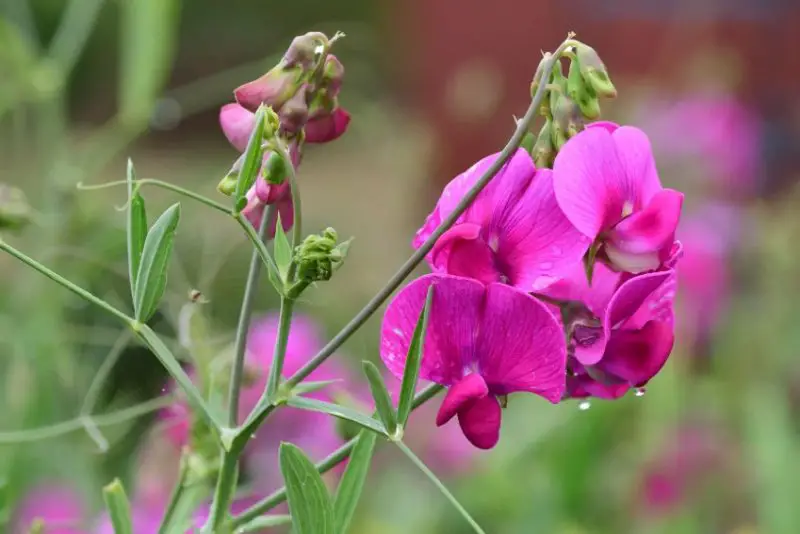Sweet pea flowers, with their delicate petals and enchanting fragrance, have captivated gardeners for centuries. These charming blooms come in a variety of vibrant colors, making them a popular choice for gardens, bouquets, and decorative arrangements.
If you’re looking to grow sweet peas that flourish beautifully, this comprehensive guide covers everything you need to know about planting, caring for, and maintaining these exquisite flowers.
What are Sweet Pea Flowers?

Sweet pea flowers (Lathyrus odoratus) are delicate, annual climbing plants celebrated for their enchanting fragrance and vibrant, butterfly-like blossoms. Originating from the Mediterranean region, particularly the island of Sicily, they were first cultivated in the 17th century by a Sicilian monk named Francisco Cupani, who was captivated by their captivating scent. Since then, sweet peas have gained worldwide popularity, becoming a staple in gardens and floral arrangements.
These charming flowers grow on vines that can reach heights of 6 to 8 feet, supported by tendrils that cling to trellises, fences, or other structures. Their blossoms come in an array of vivid colors, including shades of pink, purple, red, white, and blue. Some varieties even display bi-colored petals, adding a striking visual appeal. The flowers typically bloom from late spring to early summer, though the blooming period can be extended in cooler climates.
Sweet peas are not only admired for their beauty but also for their rich, sweet fragrance, which is reminiscent of honey and orange blossoms. This intoxicating scent makes them a popular choice for bouquets, weddings, and other special occasions. In the language of flowers, sweet peas symbolize blissful pleasure, gratitude, and goodbyes, making them a meaningful addition to any floral arrangement.
These plants thrive in well-drained, fertile soil with plenty of sunlight. They prefer cool temperatures and require regular watering to keep the soil moist but not waterlogged. To encourage continuous blooming, gardeners often remove spent flowers, a process known as deadheading. Despite their delicate appearance, sweet peas are relatively easy to grow, making them suitable for both novice and experienced gardeners.
It is important to note that while sweet pea flowers are beautiful and fragrant, their seeds are toxic if ingested. They contain a compound called lathyrogens, which can be harmful to humans and pets. Therefore, caution should be exercised when planting them in areas accessible to children and animals.
Overall, sweet peas are cherished for their romantic allure, delightful scent, and historical significance, continuing to inspire gardeners, florists, and flower enthusiasts around the world.
Types of Sweet Pea Flowers
Sweet peas (Lathyrus odoratus) come in a variety of types, each with its own unique features and charm. These types have been cultivated to suit different gardening needs, from fragrant cottage gardens to vibrant floral displays. Here are the most popular types of sweet pea flowers:
Grandiflora Sweet Peas
Grandiflora sweet peas are the oldest cultivated variety, cherished for their intense fragrance and delicate, small blooms. They were first developed in the late 19th century and have maintained their vintage charm ever since. These flowers typically have 3 to 4 blossoms per stem with slightly ruffled petals that give them a soft, romantic appearance.
Fragrance: Exceptionally fragrant, making them perfect for scented bouquets and aromatic garden corners.
Appearance: Small, dainty flowers in pastel shades, including pink, lavender, white, and light blue.
Growth Habit: They grow on climbing vines, reaching about 5 to 6 feet in height, requiring support from trellises or fences.
Best Use: Ideal for cottage gardens and vintage-style floral arrangements due to their nostalgic look and sweet scent.
Popular Varieties: ‘Cupani’s Original’ (the oldest known variety), ‘Miss Willmott,’ and ‘America’ (a bi-colored classic).
Spencer Sweet Peas
Spencer sweet peas are known for their large, ruffled petals and wide range of vibrant colors. Developed in the early 20th century, they became popular for their dramatic appearance and elegance. They typically have 4 to 5 blooms per stem, with long, sturdy stems that make them perfect for cutting.
Fragrance: Moderately fragrant, though not as strong as Grandiflora varieties.
Appearance: Showy, frilly petals that create a voluminous effect, available in bold colors like deep purple, bright pink, red, and even bicolors.
Growth Habit: Vigorous climbers that can grow up to 8 feet tall, needing robust support structures like arches or obelisks.
Best Use: Popular for exhibitions, floral competitions, and elegant bouquets due to their striking and formal appearance.
Popular Varieties: ‘King Edward VII’ (vivid crimson), ‘Sir Jimmy Shand’ (lavender and white bicolor), and ‘Countess Spencer’ (soft pink).
Cuthbertson and Multiflora Sweet Peas
These are robust, vigorous varieties known for producing multiple blooms per stem, offering abundant flowering. They are bred for their reliable performance and long-lasting flowers, making them excellent choices for cutting gardens.
Fragrance: Light to moderate fragrance, suitable for indoor floral displays.
Appearance: Large, bold flowers with strong stems that support multiple blooms, ensuring a full and lush look.
Growth Habit: High-yielding climbers reaching up to 6 to 7 feet, thriving with regular feeding and support.
Best Use: Perfect for cutting gardens and long-lasting bouquets, as they retain their freshness and vibrant colors for extended periods.
Popular Varieties: ‘Explorer’ (bright red), ‘Spring Sunshine’ (early blooming), and ‘Royal Navy Blue’ (deep violet-blue).
Dwarf and Bush Varieties
Unlike traditional climbing sweet peas, dwarf and bush varieties are compact plants that grow in a more bushy, upright form, making them ideal for small spaces. They generally reach heights of 8 to 24 inches and do not require staking or trellising for support.
Fragrance: Typically less fragrant than climbing varieties, but still charming.
Appearance: Smaller, charming blooms in a variety of colors, perfect for creating a colorful ground cover or container display.
Growth Habit: Compact, bushy growth suitable for containers, window boxes, and small garden borders.
Best Use: Ideal for containers, hanging baskets, and small garden spaces, as they are low-maintenance and don’t need support structures.
Popular Varieties: ‘Cupid Series’ (dwarf bicolors), ‘Bijou’ (early blooming), and ‘Explorer Bush’ (bright and compact).
Choosing the Right Type for Your Garden
When selecting sweet peas, consider the space available and the desired purpose. For strong fragrance and vintage charm, Grandiflora varieties are the best choice. If you’re aiming for show-stopping displays or floral competitions, opt for the Spencer types. Cuthbertson and Multiflora varieties are perfect for cutting gardens and long-lasting bouquets, while Dwarf and Bush varieties are excellent for containers and small spaces.
How to Grow Sweet Pea Flowers
Growing sweet peas (Lathyrus odoratus) is a rewarding endeavor, as they provide vibrant colors and delightful fragrance. Although they are relatively easy to grow, paying attention to location, soil preparation, planting, support, and ongoing care can make a big difference in achieving healthy, blooming plants. Here’s a detailed guide to help you grow sweet pea flowers successfully:
Choosing the Right Location
Sweet peas thrive best in a sunny location with at least 6 to 8 hours of direct sunlight per day. Adequate sunlight promotes strong growth and abundant flowering. However, in extremely hot climates, providing some light afternoon shade can help prevent the blooms from fading.
Select a site with well-drained, fertile soil to avoid waterlogging, which can cause root rot. If your soil tends to retain water, consider planting sweet peas in raised beds or containers to improve drainage. Good air circulation is also essential for preventing fungal diseases such as powdery mildew.
Preparing the Soil
Sweet peas prefer slightly alkaline soil with a pH between 7.0 and 7.5. It is beneficial to test your soil’s pH before planting. If the soil is too acidic, adding garden lime can help raise the pH to the desired level.
To enhance soil fertility and drainage, enrich the soil with organic matter:
- Compost or well-rotted manure: These improve the soil structure and provide essential nutrients.
- Bone meal or superphosphate can also be added to encourage root development.
Loosen the soil to a depth of about 12 inches to allow the roots to grow deeply and establish a strong support system. Break up any clumps and remove stones or debris. This also improves aeration and drainage.
Planting Sweet Pea Seeds
When to Plant:
- In mild climates (zones 8-10): Plant seeds in late fall for early spring blooms. The cooler winter temperatures encourage robust root development.
- In colder climates (zones 3-7): Start seeds indoors 6 to 8 weeks before the last expected frost date. Transplant them outdoors when the soil is workable in early spring.
How to Plant:
- Pre-soak the seeds: Sweet pea seeds have a tough outer shell. Soaking them in water for 12-24 hours softens the shell, improving germination. Alternatively, lightly nicking the seed coat with a nail file or sandpaper also works well.
- Sow the seeds 1 inch deep and 2 to 3 inches apart in well-prepared soil or in seed trays. Cover them lightly with soil and water gently.
- Germination typically occurs within 10 to 14 days. Maintain a soil temperature of 55°F to 65°F (13°C to 18°C) for optimal results.
- Thin the seedlings to about 6 inches apart once they are established. This spacing ensures good air circulation and prevents overcrowding, reducing the risk of fungal diseases.
Transplanting Seedlings:
- If starting indoors, harden off the seedlings by gradually exposing them to outdoor conditions for about a week before transplanting.
- Transplant them outdoors once the danger of frost has passed, being careful not to disturb the roots. Space them 6 inches apart in rows or blocks.
Providing Support for Climbing Varieties
Most sweet peas are climbing vines that require support to grow upright and display their blooms beautifully. Providing support early on encourages healthy growth and prevents sprawling.
- Install supports at the time of planting to avoid damaging the roots later.
- Trellises: Place sturdy trellises about 6 to 8 feet high for the vines to climb.
- Stakes and Netting: Use bamboo stakes or metal poles with garden netting or twine.
- Obelisks or Arches: These decorative structures provide excellent climbing surfaces while adding vertical interest to your garden.
- Tying the vines: As the vines grow, gently tie them to the support structures using soft garden ties or twine. The tendrils will naturally wrap around the supports as they grow.
Caring for Sweet Pea Flowers
Proper care is crucial for healthy growth and abundant blooms. Here’s how to care for sweet pea flowers:
Watering Requirements:
- Keep the soil consistently moist but avoid waterlogging, as overly wet soil can lead to root rot.
- Water deeply once a week, ensuring the moisture reaches the root zone. During hot or dry spells, increase the frequency as needed.
- Mulching around the base helps retain soil moisture and keep the roots cool. Use organic mulch like straw, shredded bark, or compost.
Fertilizing Sweet Peas:
- At planting time, apply a balanced, slow-release fertilizer (such as 10-10-10 NPK).
- Once the plants start blooming, switch to a high-potassium fertilizer every 4-6 weeks to promote vibrant and continuous flowering. Tomato feed works well as it is high in potassium.
- Avoid excessive nitrogen as it promotes leafy growth at the expense of flowers.
Pruning and Deadheading
- Pinching: When the seedlings are about 4 inches tall, pinch off the top set of leaves. This encourages the plant to branch out and become bushier, leading to more blooms.
- Deadheading: Regularly remove spent flowers to prevent seed formation. This practice encourages the plant to produce more flowers instead of diverting energy to seed production.
- Cutting Blooms: Harvest blooms frequently for floral arrangements. This also stimulates continuous blooming.
Pest and Disease Control
Sweet peas are susceptible to a few common pests and diseases:
Common Pests:
- Aphids: These small insects can be controlled with insecticidal soap or neem oil.
- Slugs and Snails: These pests feed on young seedlings and leaves. Use slug pellets or place barriers like crushed eggshells around the base of the plants.
- Spider Mites: In hot, dry conditions, spider mites can be problematic. Use insecticidal soap and keep the plants well-watered.
Common Diseases:
- Powdery Mildew: Ensure good air circulation and avoid overhead watering. If mildew develops, use fungicidal sprays or sulfur dust.
- Root Rot: Prevent by planting in well-drained soil and avoiding waterlogging.
- Downy Mildew: Avoid overcrowding and maintain good air circulation.
Harvesting and Enjoying Blooms
- Harvest blooms in the morning when they are at their freshest.
- Cut the stems when the lower flowers on the spike are fully open but the top buds are still closed.
- Use sharp scissors or pruning shears to make clean cuts, which prolongs vase life.
- Place the cut stems immediately in water to keep them hydrated.
End of Season Care
- When the plants begin to decline, cut the vines down to the ground and remove debris to prevent disease buildup.
- Compost the spent plants if they are disease-free.
- In mild winter regions, leave the roots in the soil to decompose naturally, enriching the soil for the next planting season.
Final Tips
- Rotate the planting area each year to minimize the risk of soil-borne diseases.
- Avoid planting sweet peas where other legumes (like beans or peas) were grown recently, as they share similar pests and diseases.
- Sweet pea seeds are toxic if ingested, so keep them away from children and pets.
Common Problems and Solutions
Poor Germination Rates
Cause: Hard seed coat or improper planting depth.
Solution: Soak seeds overnight and plant at the correct depth.
Yellowing Leaves
Cause: Overwatering or nutrient deficiencies.
Solution: Adjust watering schedule and apply balanced fertilizer.
No Flowers or Poor Blooming
Cause: Lack of sunlight or excessive nitrogen.
Solution: Ensure full sun exposure and use high-potassium fertilizer.
Companion Plants for Sweet Peas
Sweet peas pair well with several other garden plants, enhancing both aesthetics and growth:
- Nasturtiums: Repel aphids and other pests.
- Calendula: Attracts beneficial insects like pollinators.
- Foxglove and Delphinium: Complement sweet peas with their tall, colorful spikes.
Harvesting and Using Sweet Pea Flowers
When and How to Harvest
Harvest sweet pea flowers when the first blossom on the stem is fully open.
Cut stems early in the morning for maximum freshness.
Using Sweet Peas in Floral Arrangements
Sweet peas make beautiful, fragrant additions to bouquets and centerpieces.
Combine with roses, peonies, and greenery for elegant arrangements.
Extending Vase Life
Trim stems at an angle under running water to prevent air bubbles.
Change water daily and add flower preservative for longer-lasting blooms.
Tips for Growing Sweet Peas Successfully
Rotate planting locations each year to prevent soil-borne diseases.
Mulch around the base to retain soil moisture and control weeds.
Regularly check for pests and diseases to maintain healthy plants.
Frequently Asked Questions (FAQs)
Are Sweet Pea Flowers Perennial?
No, most sweet pea varieties are annuals, meaning they complete their life cycle in one growing season. However, perennial sweet peas (Lathyrus latifolius) are available but lack fragrance.
Can Sweet Peas Grow in Pots?
Yes, dwarf and bush varieties are suitable for container gardening. Use a deep pot with good drainage and provide a small trellis for support if needed.
Why Are My Sweet Peas Not Blooming?
This could be due to insufficient sunlight, too much nitrogen, or improper pruning. Ensure they receive full sun and avoid over-fertilizing with nitrogen-rich products.
Are Sweet Peas Toxic?
Yes, sweet pea seeds and pods are toxic if ingested. Keep them away from pets and children.
Conclusion
Sweet pea flowers bring charm, fragrance, and vibrant colors to any garden. By understanding their growing needs and providing the right care, you can enjoy a stunning display of blooms throughout the season. From selecting the right variety to mastering planting techniques, watering, fertilizing, and pest management, this guide equips you with all the knowledge needed for successful sweet pea cultivation.
Whether you’re a beginner or an experienced gardener, growing sweet peas is a rewarding endeavor that fills your garden with delightful scents and mesmerizing colors. Happy gardening!






